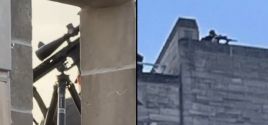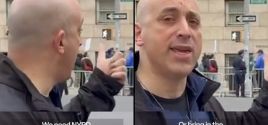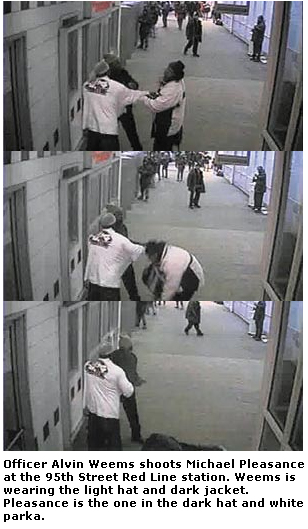Killed on CameraOfficer Alvin Weems shot an unarmed man point-blank in view of CTA security cameras. Investigators recommended that he be fired. Phil Cline promoted him.By John Conroy Chicago Reader May. 06, 2007 |
Popular 
'Sniper Seen on Roof Overlooking Pro-Palestine Protest' at Indiana University

ADL Urged Congress to Pass FISA Law Spying on Americans to 'Protect Israel'

Mike Johnson Pushes Debunked Lie That Israeli Babies Were 'Cooked in Ovens' On October 7

Axios Poll: Majority of Americans Now Want Mass Deportations

Claim Jewish Student Was 'Stabbed In The Eye' by Pro-Palestine Protester Draws Mockery After Video Released
  LAST DECEMBER SIX off-duty Chicago police officers reportedly attacked four businessmen in a bar, leaving one in need of reconstructive surgery and another with four broken ribs. In February off-duty officer Anthony Abbate beat up a young female bartender who declined to serve him any more drinks. Both incidents were recorded by security cameras. LAST DECEMBER SIX off-duty Chicago police officers reportedly attacked four businessmen in a bar, leaving one in need of reconstructive surgery and another with four broken ribs. In February off-duty officer Anthony Abbate beat up a young female bartender who declined to serve him any more drinks. Both incidents were recorded by security cameras.Outgoing police superintendent Phil Cline said he was “disgusted” by the assaults. He said what dismayed him wasn’t just the beatings but also how the attackers were subsequently protected by the department. Commanders kept the offenders in the December incident on active duty for months, even after seeing the recording. In videotape of February’s incident, Abbate can be seen repeatedly punching and kicking bartender Karolina Obrycka, yet he was only charged with a misdemeanor till the state’s attorney’s office brought more serious charges. A police captain ordered his men to harass the media who came to cover Abbate’s first court hearing. “I won’t tolerate any misconduct. If it comes to a criminal nature, we’ll arrest you. If somebody tries to shield Officer Abbate, or any other officer accused of misconduct, then they’re going to have to pay the consequences for it,” Cline said after that hearing. But this isn’t anything Cline hasn’t seen before. In 2003, when an officer Cline had worked with years earlier got into trouble, Cline and other high-ranking officers helped make the problem go away. That problem was caught by security cameras too. That victim wasn’t beaten—he was shot dead. The full tape of the incident has never been shown publicly, and nobody’s apologized to the victim’s mother. The damn thing about it is that Michael Pleasance would probably be alive today if the two officers assigned to cover the Red Line station at 95th Street hadn’t been late for work. Alvin Weems and Donald Johnson worked for the CPD’s Public Transportation Section. While they were with that unit they rotated to various sites, not knowing where they’d be posted from one day to the next. On Saturday, March 8, 2003, Weems and Johnson were supposed to report to the 95th Street station at 6 AM. Weems arrived at 6:17, Johnson was nowhere in sight, and the two officers on the midnight shift had already left. As Weems parked his car, a fight inside the terminal involving several men, perhaps as many as six, had already been in progress for several minutes. When he spotted the brawl, Weems dropped his equipment bag on the floor, drew his off-duty weapon, a Ruger SP 101, and ran past the ticket agent’s booth to the turnstile area, where the fight was taking place. He would later say he identified himself and told everyone to get on the ground. Some witnesses said they heard this, others didn’t. He wasn’t immediately identifiable as a policeman: He had on a knit stocking cap and wore a black winter jacket over his police shirt. Several CTA security cameras were positioned throughout the terminal, and two recorded some of the action that morning. Camera 7 picks up 23-year-old Michael Pleasance strolling into the terminal. He’s carrying a jacket that belongs to his friend Patrick Anderson, and he seems to be looking for Anderson, who’s fighting off camera near the turnstiles. If Pleasance knows his friend is in a fight, his pace suggests he isn’t in a big hurry to find it. Camera 8 watches Pleasance’s back as he passes an elevator. Weems passes the same spot an instant later—6:17:01 AM, according to police documents—and you can see a flash of the gun in his left hand as he runs toward the fight. Weems rounds the elevator, disappears from view, and then reappears a few seconds later, seemingly having approached the combat and retreated. He gazes off, away from the fight, perhaps looking for reinforcements, and then turns and heads back toward the fight, dropping once again from view. Seventeen seconds later, a man who seems likely to have been one of the participants in the fight runs toward the camera, away from the scene. Then Weems reappears, pushing Anderson in front of him. Anderson is 30 years old, five foot seven, 210 pounds—a man of some heft. Weems, 40 pounds lighter and two inches shorter, pushes Anderson toward a tiled wall near the terminal’s Dunkin’ Donuts store, his right hand grasping Anderson’s shirtfront, his left hand waving his gun around. There is no audio on the CTA’s security tape. Anderson looks bellicose and agitated, and keeps raising his arm to point back toward the fight, perhaps suggesting that Weems focus on more-deserving culprits; it’s a gesture he will make over and over again while under Weems’s control. He doesn’t appear to be making any attempt to strike or overpower the officer. In that moment, Weems would certainly have welcomed the assistance of his partner, but Officer Johnson hadn’t shown up yet. Weems also would have benefited from access to his handcuffs, his pepper spray, his baton, and even his police hat, but they were all in his bag somewhere on the floor. He couldn’t call for backup as his radio was in the police room. All things considered, he had gotten himself into a jam. One solution would have been to simply let Anderson go. The apparent crime wasn’t serious—misdemeanor battery, most likely, as no one seems to have been hurt badly in the fight. And at that point Weems couldn’t have known whether Anderson had been an instigator or someone who’d been attacked. On the video, as Weems moves Anderson away from the turnstiles Pleasance follows, holding Anderson’s jacket in his left hand. Pleasance stops at Anderson’s right, in front of the officer, within a foot or so of the waving gun. Pleasance seems much calmer than Anderson or Weems, strangely unintimidated by the proximity of the weapon. Like Anderson, he seems to be disputing Weems’s take on the situation, but he’s not overly agitated or gesticulating. Pleasance momentarily switches Anderson’s jacket to his right hand. At 6:17:43 Anderson raises his right arm to point again. Pleasance raises his left hand, perhaps to evade Anderson’s rising arm, or perhaps to point at the turnstile area himself. Pleasance stands flat-footed, not pivoting or stepping or shifting his weight as if to land a blow. An instant later, at 6:17:44, Weems raises the Ruger and shoots Pleasance in the head. Pleasance drops from the frame. Over the next 90 seconds, the CTA cameras show, Weems and Anderson continue talking. Anderson points repeatedly toward the turnstiles. They move down the corridor, away from Pleasance’s body. Weems kicks a leg out from under Anderson, who goes down. They wrestle and then stand again, Anderson still in Weems’s control. While all this unfolded, 911 operators started receiving calls about the incident. “We got about six guys fighting in the station,” said the first caller. Three minutes later, calls reported gunfire, none indicating that the shooter was a policeman. “One is shot,” reported a bus driver. “He’s sticking up another one now. . . . This man is crazy. He has a gun, he’s already shot one person.” At 6:20 officers responding to the emergency calls started to arrive at the station. According to the report on the incident eventually filed by the police department’s Office of Professional Standards, Anderson was by then fully cooperative. Officer Richard Griffin ordered Weems to drop his gun. He laid it on the ground. Officer Tiffany Walker later recalled “angry voices everywhere” and “the crowd shouting, ‘He shot him!’” Griffin handcuffed Weems and took him to the police room nearby. Anderson was cuffed and taken away in a squad car. Pleasance was taken to Christ Advocate Hospital, where he was pronounced dead on arrival. Officer Johnson arrived for work at 6:45. AFTER THE SHOOTING Weems filled out a tactical response report in which he indicated that Pleasance had attacked him. According to a copy of the general offense case report filed by officers Walker and Griffin, someone (in the poor copy we obtained lines are missing that might say who) said to Weems, “You ain’t taken (sic) nobody to jail. You will have to shoot all of us,” and Pleasance came up from behind him swinging with a closed fist. An “officer’s battery report” filled out by Sergeant Kevin Chambers had Pleasance saying, “I don’t care if you are the police, you ain’t taking him, motherfucker. We are going to fuck you up.” The report went on to say that “at this point in time the offender . . . lunged at P.O. Weems. P.O. Weems, who was holding his weapon in his left hand, put his left arm up in defense of the offenders impending strike. The offenders right arm/fist area came into contact with P.O. Weems’ left hand, which was holding his weapon. The weapon discharged at this point in time once, striking Pleasance in the upper body area.” Assistant deputy superintendent Sandra Day, the highest ranking officer to come to the scene, also filed a report that day, a “to/from” memo addressed to “First Deputy Superintendent, Bureau of Operational Services.” Day said she’d had a one-on-one interview with Weems and he’d told her that there had been four men fighting, with Pleasance in the thick of the battle. When Weems separated the combatants, Day’s account went on, Pleasance and Anderson called him “punk” and said, “We don’t care if you’re the police, we will get your gun and fuck you up Mother Fucker.” According to Day, Weems drew his weapon at that point “in fear of his safety and continued to hold offender Anderson while fending off advances from both offenders. Both offenders continued to verbally threaten the officer. As offender Pleasance lunged at Officer Weems his weapon discharged.” In the wake of a police shooting the department conducts a “roundtable,” a procedure that’s supposed to suggest whether charges against the officer might be in order. Police and witnesses testify before assembled representatives from the Office of Professional Standards, the state’s attorney’s office, and the police department. The roundtable on the Michael Pleasance shooting, presided over by Sandra Day, began at 1:40 PM the day of the shooting. Weems didn’t appear, which was his option. Day’s memo, written after the roundtable, said “victims and witnesses to this incident” participated in it and “all parties related the same account of the incident as indicated by P.O. Weems.” But the unanimity of the seven witnesses listed in Day’s account is absent in the final report of Area Two Violent Crimes detective Paul Alfini, in which two of those witnesses had Pleasance saying “Put the gun up, you don’t need to do that,” and “I don’t care if you are the police, put the gun away,” while a third witness recalled Pleasance repeatedly calling Weems a “punk” but also saying “This isn’t necessary.” Day’s report went on to make an even more surprising statement. “In addition, the undersigned and supervisory personnel from Area 2 Detective Division later returned to the CTA office . . . to view the digital tape of the shooting incident. The recording shows the same account of the circumstances as related by Officer Weems and the witnesses account to the incident.” In fact, the tape shows Weems with his weapon drawn from the outset. It doesn’t show Pleasance lunging or doing anything else that could be construed as a threat to Weems’s life. Day concluded by saying that Weems’s actions “were in compliance with Department procedures and directives.” Neither her report nor Alfini’s mentioned the absent Officer Johnson, or that Weems arrived late, or that he went into action improperly attired and equipped, without access to nonlethal force. Police press spokesman Pat Camden shaped the Tribune’s coverage the day after the incident. The paper reported that “a mass transit officer . . . was arriving for his shift when he saw a group of six or seven men kicking another man on the ground near a turnstile. . . . The officer identified himself, Camden said, and told the group to stop. He then began walking one of the men toward the elevator. The other men tried to block his way and became verbally and physically abusive, Camden said. The officer feared for his life and drew his gun, Camden said. One of the men either ran into the officer or tried to take away the weapon and the gun discharged, striking Michael Pleasance in the neck.” Camden was quoted as saying, “You’ve got seven people attempting to take an individual in custody from a police officer. They were trying to defeat the arrest.” In his final report on the incident, submitted August 7, 2003, Detective Alfini concluded that Patrick Anderson had committed a felony—aggravated battery on a public way. Alfini said Weems’s shooting should be classified a justifiable homicide because the officer “took lawful and proper Police action” in response to Pleasance’s “attempt to interfere with and disarm a Peace Officer (a Felony) while in the course of a lawful arrest.” OPS investigator Ivette Cotto interviewed Weems on June 13, 2003. Weems arrived with his attorney. He said he understood that any deviation from the truth could result in charges being placed against him. He said he was late reporting to the 95th Street terminal because he’d had to stop for gas, but because he knew he’d only be a few minutes late he didn’t think it was necessary to notify anyone. He claimed to have arrived at 6:04 AM. He said he always changed clothes in the police room and didn’t wear his duty belt in the car because “it damages the vehicle.” Weems told Cotto that when he came into the station, he saw one man beating another at the turnstiles. To the best of his recollection, only two men were fighting. Weems indicated that he dropped his bag about 50 feet from the turnstiles, ran to the fight, pulled off the man who had the upper hand and identified himself as the police, and then told this man he was under arrest and must come to the police room. Weems claimed he hadn’t yet drawn his weapon. “He told me that he wanted to explain to me what was going on and I told him to explain to me in the room. He was spinning his body trying to get away from me. I was trying to grab his arm and secure him. When I tried to secure him, some guys started to surround me and say stuff to me.” “How many guys?” Cotto asked. “At least four, maybe five. They were all around me. . . . They said, ‘Fuck you if you’re the police. You ain’t taking our boy with you. You are by yourself. First chance we get, we gonna fuck you up.’” Weems said all of the men were saying that, but at some point Pleasance got in front of him and started saying “more stuff like that. . . . When I saw that I was surrounded I took my gun out . . . ’cause I was in fear of my life.” Weems said the closest of the men was about three feet away, the farthest about five. “Pleasance stood in front of me. ‘You ain’t taking my boy with you. Before you take my boy with you, you gonna have to kill all of us.’ Then he stepped toward me. . . . He came at me in a menacing manner as if he was going to carry out his threats. . . . I didn’t give him a chance to touch me. . . . I stuck my left hand out to keep him off me. . . . He was making threats at me and came up towards me with one hand. . . . He just had it cocked back. . . . I don’t have a clear recollection of pulling the trigger but at the time the weapon discharged I believed I was in fear of receiving a battery and that they would carry out their threats, I thought they would cause serious bodily harm to me or kill me.” Police department regulations on the use of force are summarized in two pages of a handbook provided to officers by the Fraternal Order of Police. It explains that an officer is allowed to use deadly force only in very specific circumstances, none of them covered by the events as captured in the CTA video. When Cotto asked Weems to describe Pleasance’s actions “relative to the use of force model,” Weems consulted his FOP handbook and then said, in almost an exact quote from the manual, that Pleasance “was an assailant and I thought his actions might cause death or serious injury to me.” OFFICER DONALD JOHNSON, who arrived 45 minutes late for work the day of the shooting, had also filed a to/from report that day. It said he’d tried “several times” to call his unit. In his statement to OPS, he said he’d tried to call in to report that his car had broken down. But he couldn’t support this story with cell phone evidence, and finally he acknowledged he was “not 100 percent sure” that he had called in at all. The summary report by OPS investigator Cotto is dated May 1, 2004—that’s 420 days after the shooting. She’d collected interviews with 16 witnesses and numerous police officers. She sustained five charges against Johnson: failure to be prompt for duty, failure to report any anticipated absence from duty, conduct that brought discredit upon the department, and two charges of making a false report. Cotto sustained ten charges against Weems: failure to be prompt, failure to report an anticipated absence from duty, three charges of display of a weapon “without justification” (for drawing his gun before assessing the risk level at the scene, for pointing his gun at Pleasance, and for pointing it at Anderson), inattention to duty (“in that he discharged his weapon at Michael Pleasance resulting in his death”), unwarranted use of deadly force, failure to carry his off-duty weapon in a department-approved holster, bringing discredit upon the department, and making a false report. The false report charge was for claiming to Cotto that he’d been late only four minutes, that he’d been surrounded by a number of males before pointing his weapon at anyone, that Pleasance had charged at him, that he’d hit Pleasance with his gun before discharging it, and that he’d had reason to point the gun at Anderson. Lori Lightfoot, then chief administrator of the Office of Professional Standards, approved the findings against both officers in a memo to Superintendent Cline dated May 20, 2004. In the memo she recommended that Johnson be suspended for 45 days. According to a high-ranking OPS source, she recommended in a separate document that Weems be fired. CLINE, IT TURNS OUT, had crossed paths with Weems before. They’d served together in the west side’s 11th District, Cline as a lieutenant, Weems on patrol. On April 3, 1990, the Tribune published an article by Anne Keegan that said the 11th District led the city in murders, serious crimes, and calls to the police. The district, known officially as Harrison, was informally referred to as Fillmore—its name until its quarters had been moved 12 years earlier. If you worked in Fillmore, Keegan suggested, you’d done something wrong somewhere else, you’d stepped on some political toes, or you simply liked all the action. Cline was quoted in the story, saying that 11th District cops were more concerned about “catching the criminal” and “being the police” than with picayune department rules. “So what if their ties are loose, their hats fall off, or their shoes are scuffed,” Cline said. “What’s downtown going to do? Put them on midnights in Fillmore?” Fourteen years later Cline was “downtown,” and he had to decide what to do with Weems, who’d done his share of midnights in Fillmore, having served more than a decade on patrol there. Cline rejected Lightfoot’s recommendation that Weems be fired. Five months passed, and the department imposed no discipline at all. Weems might never even have been censured but for forces beyond the department’s control. Pamela Pleasance, Michael’s mother, wanted to sue the city, and her lawyers, Al Schwartz and Craig Mannarino of Kralovec, Jambois & Schwartz, asked private investigator John Byrne to see what he could turn up. Byrne is a retired homicide detective and sergeant (he was the right-hand man of former commander Jon Burge during the years that much of the torture of suspects took place at Area Two). “I could see the security cameras suspended from the ceiling,” he said in a recent e-mail, “and, due to their positions, I realized that they had to have captured some of the events that occurred.” Schwartz and Mannarino filed a motion in circuit court to get the CTA to preserve and provide the video. In August 2003, law division judge Diane Joan Larsen ordered the CTA to turn over a DVD but told Schwartz and Mannarino not to publicize or publish it. The following February, Schwartz and Mannarino filed suit against the city, the CTA, and Weems, and in October 2004 another law division judge, Jeffrey Lawrence, lifted the ban on circulating the DVD. The lawyers didn’t rush copies to the TV stations. In a recent e-mail, Mannarino said he believed his side would enjoy more leverage if broadcasting remained something they might do rather than something they’d done, and they also wanted to spare Pamela Pleasance the experience of seeing her son’s execution on television. The police department, however, clearly expected to see the tape on TV in short order, and Cline was ready to put his spin on it. He held a news conference within hours of the judge’s order. In the TV and newspaper coverage Cline didn’t mention that the city and Weems had fought to keep the tape from being released. Nor was there mention of Johnson’s absence from the scene. And although Cline mentioned that Weems had been late for work, he didn’t explain that if he had arrived on time he would have had his radio, pepper spray, and baton, and the authority provided by his uniform to help deal with the situation. Cline didn’t report that OPS had sustained charges against Weems for lying, for bringing discredit onto the department, and for unlawful use of a weapon. He didn’t mention that OPS chief investigator Lightfoot had recommended Weems be fired. The TV coverage said Pleasance had been one of the fighters in the terminal. Showing a snippet of a few seconds’ duration, the portion of the video in which Pleasance is shot, Channel Two reporter Suzanne Le Mignot said, “As Officer Weems struggles to get Anderson under control, watch as Pleasance takes a swing at him. Officer Weems tries to block the blow with his left hand while holding his service revolver. His finger is also on the trigger.” She cut to Cline at the news conference. “Unfortunately, because the officer is still holding the struggling Anderson, the only arm that was free was the arm holding the gun,” he said. “The gun went off, striking Pleasance and killing him. . . . Patrick Anderson, who had been three times in the penitentiary, ignored repeated orders to obey and instead struggled with the officer.” Le Mignot: “At one point during the struggle police said Pleasance approached the officer from behind and threatened him.” Cline: “He told the officer that he would have to use his gun, that his friend Anderson was not going to jail, and that the officer would have to kill him first.” Le Mignot: “Superintendent Cline said this tape is a prime example of what police officers face on a daily basis, but also what can happen when they don’t follow department rules.” Cline: “The public demands that the officers be held to a very strict standard. We understand that because we understand the tremendous responsibility and trust that the public places in us.” Cline announced that Weems would be suspended for 30 days without pay. The next day’s Tribune explained that the suspension was the result of Weems having his finger on the trigger, which is not allowed unless the officer intends to fire. Cline also said that Weems’s tardiness had been a factor in the decision to suspend him. The shooting itself, Cline said, was accidental. The Sun-Times had Cline saying, “One of the most unfair things we can do to an officer is Monday-morning quarterback him from the safety and sanctuary of our offices.” In 2005, Cline promoted Weems to detective. Through police press spokesperson Monique Bond, Cline declined to respond to the Reader’s questions about the incident, citing pending litigation, although the same litigation was pending when he held his press conference on October 22, 2004. PAMELA PLEASNCE’S CIVIL suit progresses slowly, in part because the city has repeatedly ignored court orders to supply documents. Weems gave a deposition on December 20. In answer to Mannarino’s questions, Weems said he had “no idea” why he’d been suspended, didn’t think he should have been, and hadn’t done “anything too much wrong.” Pressed to say what he had done wrong, Weems replied that he’d been late for work and had “accidentally shot Mr. Pleasance.” He admitted that he wasn’t wearing anything that would visibly identify him as a police officer, that contrary to what he’d told OPS he hadn’t feared for his life, that he didn’t think Pleasance’s actions would cause him serious injury or death, and that he hadn’t been surrounded the moment before he’d fired. He said he hadn’t intended to shoot Pleasance because Pleasance had done nothing to warrant being shot. One of his problems that morning, he said, was that Anderson and Pleasance just wouldn’t cooperate. He said they told him he’d heard only half the story but wouldn’t go with him to the police room to tell their side, and Pleasance wouldn’t back up. “I was telling him to step back and leave us alone because it wasn’t that serious. . . . All he [Anderson] was going to be arrested for was battery.” Weems said that he’d pulled his weapon out early because he was by himself, didn’t have a radio, and thought he was approaching a gang fight and the fighters might be armed. Although the 95th Street station has “a lot of gang fights,” he said, if the same event had taken place at the Fullerton Avenue Red Line stop he’d have done the same thing—run up to the fight with his gun drawn. [email protected] |



